The Medals of Azad Hind or Arzi Hukumat E Azad Hind (Provisional Government of Free India) was established by Netaji Subhas Chandra Bose while he was in Germany. These esteemed decorations were initially aimed to award the members of the Azad Hind Legion (Legion Freies Indien or Tiger Legion) for courage and valour in the field of battle. Both Indian members as well as Germans were qualified for the decorations. Eventually the same set of medals was instituted by the Arzi Hukumat E Azad Hind government for the soldiers of the Indian National Army or Azad Hind Fauj during their campaign in South East Asia.
The different types of Medals of Azad Hind are mentioned as follows-
Sher E Hind
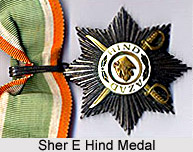 The medal of Sher E Hind, meaning Tiger of India, was the highest military decoration of the Azad Hind Provisional Government, which was an Indian government in exile established in the year 1943 in Singapore. The Grand Star was a neck order and the award could be conferred with swords for bravery in combat and without swords for non-combat awards. Two awards were presented by the government, one to Captain Ganeshi Lal and the other to Captain Kunwal Singh.
The medal of Sher E Hind, meaning Tiger of India, was the highest military decoration of the Azad Hind Provisional Government, which was an Indian government in exile established in the year 1943 in Singapore. The Grand Star was a neck order and the award could be conferred with swords for bravery in combat and without swords for non-combat awards. Two awards were presented by the government, one to Captain Ganeshi Lal and the other to Captain Kunwal Singh.
Sardar E Jung
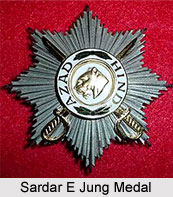 The Sardar E Jung (Leader of Battle) medal was the 2nd highest military decoration that was awarded by the Arzi Hukumat E Azad Hind. It was a 1st Class Star. Sardar E Jung was a Badge and could be conferred without swords for non-combat awards and with swords for bravery in combat. At least two awards were bestowed, one to Captain Shanghara Singh Mann and the other to Colonel Shaukat Hayat Malik for the capture of Moirang. Captain Shanghara Singh Mann was also awarded the Vir E Hind medal as well.
The Sardar E Jung (Leader of Battle) medal was the 2nd highest military decoration that was awarded by the Arzi Hukumat E Azad Hind. It was a 1st Class Star. Sardar E Jung was a Badge and could be conferred without swords for non-combat awards and with swords for bravery in combat. At least two awards were bestowed, one to Captain Shanghara Singh Mann and the other to Colonel Shaukat Hayat Malik for the capture of Moirang. Captain Shanghara Singh Mann was also awarded the Vir E Hind medal as well.
Vir E Hind
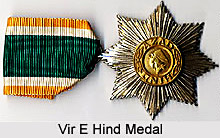 The medal of Vir E Hind, meaning Warrior of India, was the 3rd highest military decoration of the Azad Hind Provisional Government. It was a 2nd Class Star. The Vir E Hind award was a 2nd Class Star and was below the medal of Sardar E Jung (Leader of Battle). It was a medal and the award could be conferred with swords for bravery in combat and without swords for non-combat awards. At least 1 award was presented by the government to Captain Shanghara Singh Mann. He was also awarded the Sardar E Jung medal as well.
The medal of Vir E Hind, meaning Warrior of India, was the 3rd highest military decoration of the Azad Hind Provisional Government. It was a 2nd Class Star. The Vir E Hind award was a 2nd Class Star and was below the medal of Sardar E Jung (Leader of Battle). It was a medal and the award could be conferred with swords for bravery in combat and without swords for non-combat awards. At least 1 award was presented by the government to Captain Shanghara Singh Mann. He was also awarded the Sardar E Jung medal as well.
Shahid E Bharat
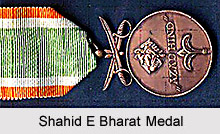 The Shahid E Bharat (Martyr for India) medal was an award of the Provisional Government of Free India that was instituted to honour the fallen soldiers of the Azad Hind Fauj. The medal was awarded in gold or in silver and was only awarded with swords.
The Shahid E Bharat (Martyr for India) medal was an award of the Provisional Government of Free India that was instituted to honour the fallen soldiers of the Azad Hind Fauj. The medal was awarded in gold or in silver and was only awarded with swords.
Tamgha E Bahaduro
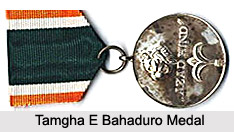 The medal of Tamgha E Bahaduro was a medal for the soldiers of the Indian National Army (INA) or Azad Hind Fauj. It was primarily a soldiers` medal and the award could be conferred with swords for bravery in combat and without swords for non-combat awards.
The medal of Tamgha E Bahaduro was a medal for the soldiers of the Indian National Army (INA) or Azad Hind Fauj. It was primarily a soldiers` medal and the award could be conferred with swords for bravery in combat and without swords for non-combat awards.



















